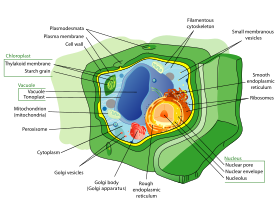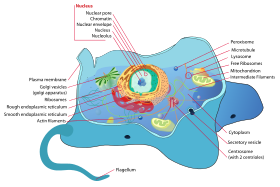CELL STRUCTURE AND FUNCTION
DEFINITION OF CELL
- A cell is the basic structural and functional unit of life.
- The word cell is derived from “cella” meaning “small room.”
- Cell is a mass of protoplasm bounded by a plasma membrane.
IMPORTANT POINTS
- Cell was discovered by Robert Hooke in 1665.
- The study of cell is known as cytology or cell biology.
- Most plant and animal cells are only visible under a microscope, with dimensions between 1 and 100 micrometers.
- The cell theory was given by Matthias Jacob Schleiden and Theodore Schwann in 1839.
- In 1885, Virchow proposed the idea that all cells arise from pre-existing cells.
- Cell is of two types, Eukaryotic (contains nucleus) and Prokaryotic cell (devoid of nucleus)
- The size of majority of cell is 3-30 micron.
STRUCTURE OF CELL


A cell is formed of three parts viz.
- Cell boundaries
- Cell wall- found in plant cell and is non-living, thick envelope most important character. While it is absent in animal cell. It is permeable and made up of cellulose, hemicellulose and pectin. Since it is outer part of the cell, it provides shape and support to the cells and protects them from mechanical shocks and injuries.
- Cell membrane– it is also called plasma membrane or plasma lemma. It is extremely delicate, thin, elastic and living membrane which surrounds the cell and made up of two layers of lipids and protein. It is semi-permeable and functions as osmo-regulation of molecules. It protects internal structure and gives shape and rigidity to cell. Absent in virus.
- Cytoplasm- presents inside the cell membrane and is the site of most photo chemical reaction occurs within a cell. Mitochondria, Endoplasmic Reticulum (ER), vacuoles, ribosome are suspended in the cytoplasm.
- Nucleus- Discovered by Robert Brown in 1833. It is surrounded by nuclear membrane made up of lipo-protein. The nucleus contains hereditary material i.e. DNA.
CELL ORGANELLES AND THEIR FUNCTION
Cell Organelles | Function |
Nucleolus | ·Contains DNA which synthesizes ribosomal RNA It is spheroidal and densest organelle discovered by Fontana in 1781. |
Chromosome | · First seen by Strasburger in 1875, but name was suggested by Waldeyer in 1888. ·Chromosomes contain genes. |
Mitochondria | ·It is called power house of cell, because it produces energy currency ATP. · The name was given by C. Benda in 1898 while identified by Altman in 1886. · It is the site of Krebs cycle (aerobic respiration), capability of some protein synthesis. |
Plastids | · Chloroplast- green colored contains pigment chlorophyll which is essential for photosynthesis, contains stroma & grana where dark & light reaction occur. · Chloroplast- red, yellow, brown, orange · Leucoplast- main function is storage of food. |
Endoplasmic Reticulum | · It is of two types- Rough ER (Ribosomes are attached on it) and Smooth ER (No Ribosomes attached). ·ER forms endoskeleton to provide shape of the cell · ER membrane provides surface for increased metabolic reaction · Intracellular transport of metabolic products Helps in the formation of cell plate and nuclear membrane during cell division · Rough ER is associated with protein synthesis, Smooth ER plays crucial role in detoxifying poison and drugs · Transmission of excitement in animals. |
Golgi body | · Discovered by Camillo Golgi in 1898. · Originated from ER and they store, modify, package and condense the protein synthesized in the ribosome · Forms cell plate during cell division · It is involved in the transportation of material in the cell · Lysosomes are formed from it that helps in intracellular digestion and also work against bacteria & virus. Helps in cell renewal. Therefore, it is known as the cell’s suicide bags |
Ribosome | It is of 3-types- mRNA, tRNA, rRNA. The first two directly take part in protein synthesis while rRNA provides site for protein synthesis. |
Tonoplast (vacuole) | · It is important part in plant cell that may occupy 90% of the cell volume. · Vacuoles stores food, water, and other waste materials in the cell · Osmoregulation of molecules |
Spherosome | Mainly found in plants, takes part in fat metabolism |
Plasmadesmata | It is found in plants only. Provides metabolic contacts between cells. |
Centrosome | At the time of mitosis produces astral rays. |
DNA- Deoxyribonucleic acid
RNA- Ribonuleic acid
ATP- Adenosine triphosphate
Protoplasm– All the components of a cell including cell membrane is protoplasm. It is living part of the cell named by J.E. Purkinje.
Read more..
MITOSIS & MEIOSIS- CELL DIVISION
MENDEL’S LAW OF INHERITANCE
DIFFERENCE BETWEEN GENE AND ALLELE
CROSSING OVER- PROCESS & FUNCTION
TYPES OF THE ECOSYSTEM
ENERGY FLOW OF ECOSYSTEM
WHAT BIODIVERSITY IS-MEANING,TYPES&THREATS
BIODIVERSITY HOTSPOTS IN INDIA
IMPORTANCE OF BIODIVERSITY
This really answered my downside, thanks!
thank you for your interest